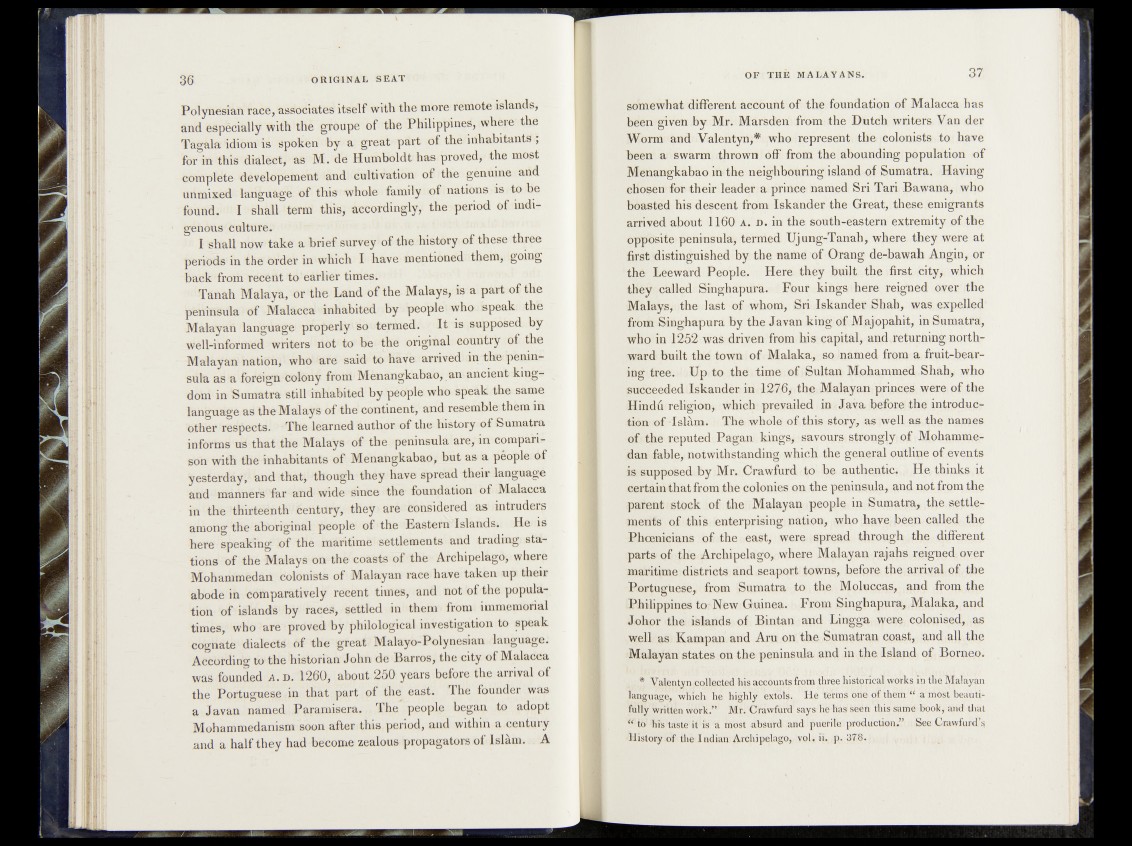
Polynesian race, associates itself with the more remote islands,
and especially with thé groupe of the Philippines, where the
Tagala idiom is spoken by a great part of the inhabitants ;
for in this dialect, as M. de Humboldt has proved, the most
complete developement and cultivation of the genuine and
unmixed language of this whole family of nations is to be
found. I shall term this, accordingly, the period of indigenous
culture. ! ■
I shall now take a brief survey of the history of these three
periods in the order in which I have mentioned them, going
back from recent to earlier times.
Tanah Malaya, or the Land of the Malays, is a part of the
peninsula of Malacca inhabited by people who. speak the
Malayan language properly so termed. It is supposed by
well-informed writers not to be the original country o fth e
Malayan nation, who are said to have arrived, in the peninsula
as a foreign colony from Menangkabao,. an-ancient king-
dom in Sumatra still inhabited by people who speak the same
language as the Malays of the continent, and resemble: them in
other respects. The learned author of the history of Sumatra
informs us that the Malays of the peninsula are, in comparir
son with the inhabitants of Menangkabao, but as a people; of
yesterday, and that, though they have spread their language
and manners far and wide since the foundation of Malacca
in the thirteenth Century, they are considered as intruders
among the aboriginal people of the Eastern Islands* He is
here speaking-óf the maritime settlements and trading stations
of the Malays on the coasts of the Archipelago, where
Mohammedan colonists of Malayan race have taken up their
abode in comparatively recent times, and not of the population
of islands by races, settled in them from immemorial
times, who are proved by philological investigation to speak
cognate dialects of the great Malayo-Polynesian - language.
According to the historian John de Barros, the city of Malacca
was founded a . d . 1260, about 250 years before the arrival of
the Portuguese in that part of the^ east. The founder was
a Javan named Paramisera. The people began to adopt
Mohammedanism soon after this, period, and within a century
and a half they had become zealous propagators of Islam. A
somewhat different account of the foundation of Malacca has
been given by Mr. Marsden from the Dutch writers Van der
Worm and Valentyn,* who represent the colonists to have
been a Swarm thrown off from the abounding population of
Menangkabao in the neighbouring island of Sumatra. Having
chosen for their leader a prince named Sri Tari Bawana, who
boasted his descent from Iskander the Great, these .emigrants
arrived about 1160 a. d. in the south-eastern extremity of the
opposite peninsula, termed Ujung-Tanah, where they were at
first distinguished by the name of Orang de-bawah Angin, or
the Leeward People. Here they built the first city, which
they called Singhapura. Four kings here reigned over the
Malays, the last of whom, Sri Iskander Shah, was expelled’
from Singhapura by the Javan king of Majopahit, in Sumatra,
who in 1252 was driven from his capital* and .returning northward
built the town of Malaka, so named from a fruit-bearing
tree. Up to the time of Sultan Mohammed Shah, who
»eeeeded Iskander in 1276, the Malayan princes were of the
Hindu religion, which'prevailed in Java before the introduction
of Isl&m. The whole of this story, as well as the names
of the reputed Pagan kings, savours strongly of Mohammedan
fable, notwithstanding which.the general outline of events
is supposed, by Mr. Crawfurd to be authentic. He thinks it
certain that from the colonies on the peninsula, and not from the
parent stock of the Malayan people, in Sumatra, tl^e settlements
of this enterprising nation, who have been called the
Phoenicians of the east, were spread through the different
parts of the Archipelago, where Malayan rajahs reigned, over
maritime districts and seaport towns, befpre the arrival of the
Portuguese, from Sumatra to the Moluccas, and from the
Philippines tor New Guinea. From Singhapura, Malaka, and
Johor the islands of Bintan and Lingga were; colonised, as
well as Kampan and Aru on the Sumatran coast, and all the
Malayan states on the peninsula and in the Island of Borneo.
* Valentyn collected his accounts from three historical works in the Malayan
language, which he highly extols. He terms one of them “ a most beautifully
Written work/’ Mr; Crawfiird sayahe has1 seen this same book, and that
'^WliVutsteifis A most absurd and puerile production.” See Crawfurd
-History of the Indian Archipelago, vol. ii. p- 378.